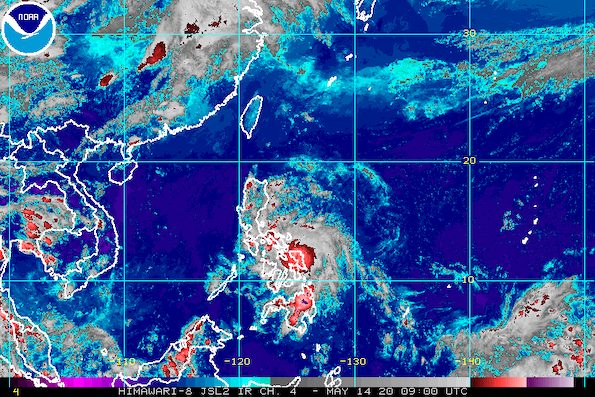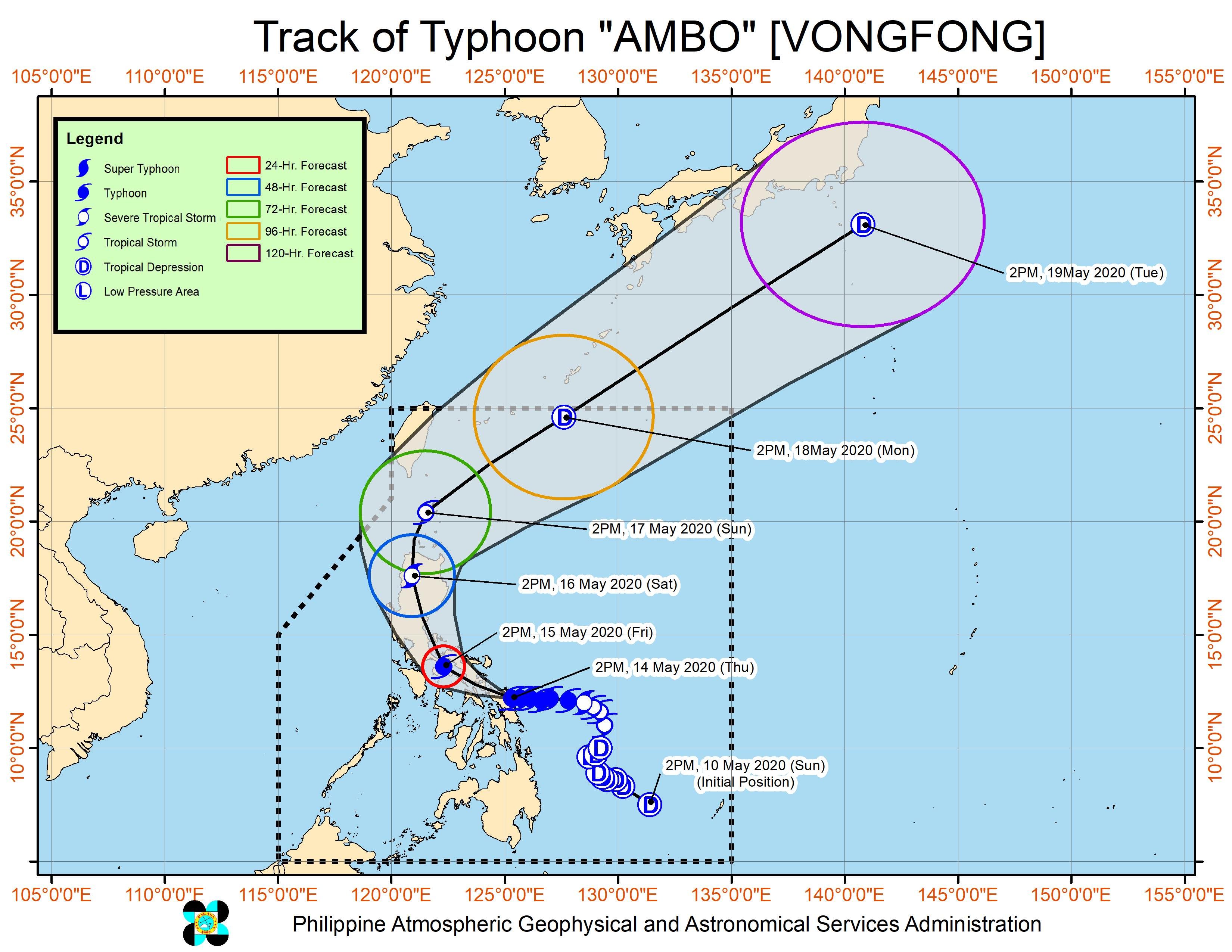SUMMARY
This is AI generated summarization, which may have errors. For context, always refer to the full article.

What’s the weather like in your area? Tweet us at @rapplerdotcom.
MANILA, Philippines – With fierce winds and heavy rainfall, Typhoon Ambo (Vongfong) moved over the northern part of Samar province late Thursday afternoon, May 14.
In an online briefing past 5 pm on Thursday, the Philippine Atmospheric, Geophysical, and Astronomical Services Administration (PAGASA) said Ambo is already in the vicinity of San Jose de Buan, Samar. It is still moving west at 15 kilometers per hour (km/h).
“The eyewall of Typhoon Ambo is bringing violent winds and heavy to intense rain over the northern portion of Samar and the southern portion of Northern Samar,” PAGASA said.
Ambo earlier made landfall in San Policarpo, Eastern Samar, at 12:15 pm on Thursday. It also brought violent winds and heavy to intense rain there.
The typhoon continues to have maximum winds of 155 km/h, but its gustiness increased to 255 km/h from the previous 190 km/h. (READ: FAST FACTS: Tropical cyclones, rainfall advisories)
More areas were placed under tropical cyclone wind signals, with several raised to the next higher classification. Below is the latest list. (READ: Why is it now called tropical cyclone ‘wind’ – and not ‘warning’ – signals?)
Signal No. 3 (winds of 121 to 170 km/h, or strong to destructive typhoon-force winds during the passage of the typhoon)
- Sorsogon
- Albay
- Masbate including Ticao Island and Burias Island
- Catanduanes
- Camarines Sur
- Camarines Norte
- southernmost part of Quezon (Tagkawayan, Calauag, Lopez, Macalelon, General Luna, Catanauan, Buenavista, Guinayangan, Mulanay, San Narciso, San Andres, San Francisco)
- Northern Samar
- northern part of Eastern Samar (Jipapad, Arteche, Maslog, Dolores, Oras, San Policarpio, Can-avid, Taft, Sulat, San Julian, Borongan City, Maydolong)
- northern part of Samar (Calbayog City, Sta Margarita, Gandara, Pagsanghan, San Jorge, Matuguinao, San Jose de Buan, Catbalogan City, Jiabong, Motiong, Paranas, Tarangnan, San Sebastian, Hinabangan)
- Biliran
Signal No. 2 (winds of 61 to 120 km/h, or strong to damaging gale-/storm-force winds during the passage of the typhoon)
- southern part of Quezon (Mauban, Sampaloc, Lucban, Tayabas, Dolores, Candelaria, Sariaya, Tiaong, San Antonio, Lucena, Pagbilao, Atimonan, Padre Burgos, Agdangan, Unisan, Plaridel, Gumaca, Pitogo, Quezon, Alabat, Perez, Real)
- Marinduque
- Romblon
- Laguna
- southeastern part of Batangas (Padre Garcia, Ibaan, Batangas City, Taysan, Rosario, Lobo, San Juan)
- northernmost part of Leyte (Calubian, San Isidro, Tabango, Leyte, Capoocan, Carigara, Barugo, San Miguel, Babatngon, Tunga, Alangalang, Sta Fe, Palo, Tacloban City, Jaro)
- rest of Samar
- rest of Eastern Samar
Signal No. 1 (winds of 30 to 60 km/h, or strong to near-gale-force winds during the passage of the typhoon)
- Aurora
- Nueva Ecija
- Bulacan
- Metro Manila
- Cavite
- Rizal
- Bataan
- Pampanga
- Isabela
- Nueva Vizcaya
- Quirino
- Tarlac
- Zambales
- Oriental Mindoro
- eastern part of Pangasinan (Lingayen, Bugallon, Aguilar, Mangatarem, Binmaley, San Carlos, Urbiztondo, Basista, Bayambang, Bautista, Calasiao, Alcala, Malasiqui, Sta Barbara, Dagupan, Mangaldan, San Jacinto, Mapandan, Manaoag, Urdaneta, Villasis, Sto Tomas, Rosales, Balungao, Umingan, San Quintin, Sta Maria, Natividad, Tayug, Asingan, San Nicolas, San Manuel, Binalonan, Laoac, Pozorrubio, Sison, San Fabian)
- rest of Quezon
- rest of Batangas
- rest of northern part of Leyte (Villaba, Kananga, Matag-ob, Palompon, Ormoc, Merida, Isabel, Ormoc City, Albuera, Pastrana, Dagami, Tanauan, Tabontabon, Tolosa, Burauen, Julita, Dulag)
- northeastern part of Capiz (Pilar)
- northeastern part of Iloilo (Carles, Balasan, Estancia, Batad)
- northern part of Cebu (Medellin, Daanbantayan, Madridejos, Bantayan, Santa Fe)
PAGASA also updated its rainfall outlook:
Thursday evening, May 14
Heavy to intense rain
- Northern Samar
- Eastern Samar
- Samar
- Masbate
- Sorsogon
Moderate to heavy rain
- Albay
- Camarines Sur
- Catanduanes
- rest of Eastern Visayas
Friday, May 15
Moderate to heavy rain, with at times intense rain
- Bicol
- Northern Samar
- Quezon
- Aurora
- Marinduque
- Romblon
Floods, landslides, and even lahar from Mayon Volcano are possible. The Philippine Institute of Volcanology and Seismology issued an advisory on Wednesday, May 13, warning that rainfall from Ambo might mix with volcanic deposits from Mayon’s 2018 eruption, which could result in lahar or volcanic mudflows.
The typhoon may also cause storm surges 2 to 4 meters high within 24 hours. These areas should be on alert for “potentially life-threatening coastal inundation”:
- Northern Samar
- Samar (west coast)
- Sorsogon
- Albay
- Catanduanes
- Camarines Sur
- Camarines Norte
- Quezon
- Aurora
Sea travel remains risky for all vessels in the seaboards of areas under tropical cyclone wind signals.
The Department of Agriculture, meanwhile, said in a virtual briefing on Thursday that 175,954 hectares of rice and 89,303 hectares of corn are at risk due to Ambo.
The typhoon is expected to leave the Philippine Area of Responsibility on Monday, May 18.

Ambo is the Philippines’ first tropical cyclone for 2020. The country gets an average of 20 tropical cyclones per year. (READ: LIST: PAGASA’s names for tropical cyclones in 2020)
In PAGASA’s climate outlook, it gave the following estimates for the number of tropical cyclones in the next 6 months:
- May – 1 or 2
- June – 1 or 2
- July – 2 to 4
- August – 2 or 3
- September – 2 or 3
- October – 2 or 3
Ambo’s arrival comes as the Philippines faces the coronavirus outbreak, with 11,876 cases as of Thursday. (READ: Social distancing ‘per family’ at Typhoon Ambo evacuation centers) – Rappler.com
Add a comment
How does this make you feel?
There are no comments yet. Add your comment to start the conversation.